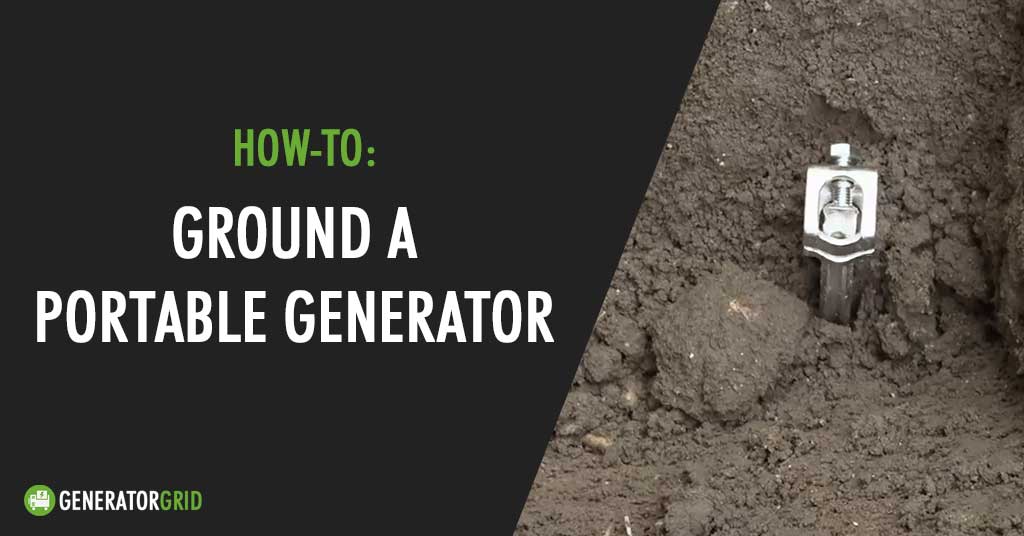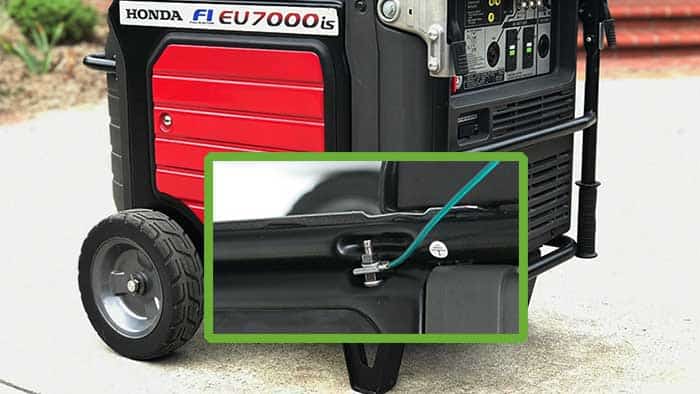Last Updated on August 11, 2023 by Manager Access

Portable generators are used for a variety of tasks, including back up home power supplies, powering tools at a job site, and many more.
Certain scenarios (like camping) may require you to ground your portable generator. You’ll need the right tools and know-how to get it done safely.
In this article, we will review what grounding is, how to tell if you need to ground your generator, the tools you will need, and the process of grounding your generator when camping or in everyday use.
What Is Grounding?
Grounding refers to connecting an electrical circuit to a reference ground.In the case of a generator, the frame of the generator acts as the electrical circuit, and a properly installed grounding rod acts as the reference ground.
Connecting a copper wire from your generator’s frame to the grounding rod grounds the generator for safe operation.
Did you know?
A short circuit in an ungrounded generator can cause a fire.
Do I Need to Ground My Portable Generator?

The easiest way to find out whether you need to ground your generator is to check your generator’s user manual.
If the user manual is not available, you can still make a few checks to ensure proper safety.
- If your generator is a separately derived system, you will need to use a grounding rod.
- If it is not a separately derived system, your generator will not need to be grounded.
To recognize a separately derived system, simply check the generator’s transfer switch. An unseparated derived system features a transfer switch that cannot be transferred to the neutral ground conductor, meaning it will not need a connection to a grounding rod.
Most portable generators have their fuel tank, engine, and housing bonded to the frame, meaning they will not have to be grounded.
Tools Needed to Ground a Portable Generator
If you have to ground your generator, make sure you are equipped with the correct tools for the job.
While most of these tools can be found on most job sites, including welding jobs, you may not have them ready at home.
Use this quick checklist to stay prepared for when you need to use your portable generator:
- A Set Of Wire Strippers In order to properly connect your copper wire to the copper rod and generator, you will need to strip the copper wire. A good set of wire strippers can help make this process cleaner, safer, and easier. In a pinch, a knife or other sharp object will work.
- Solid Copper Grounding Wire Having an ample amount of copper wire will ensure that you can connect the wire to the generator and the copper ground rod with a little extra to spare, just in case.
- 4 Foot Copper Ground Rod The star of the show and most important piece is the copper ground rod. Having the proper copper grounding rod makes all of the difference in this procedure for adequate grounding. You will need to ensure that the copper ground rod is at least 4 foot in length. You will also need to check to see how far it will need to be driven into the ground.
- Hammer/Mallet/Sledge Hammer
To drive the copper rod into the ground for proper grounding, you are going to need something to hammer it in. A quality hammer, mallet, or sledge hammer should do the job. Just be sure not to damage the copper rod’s coating as this could cause a poor connection. - Pliers
To wind the copper wire tightly around the grounding rod, a good set of pliers will definitely help out and make the connection better. - Wrench
When attaching the copper wire to the generator, a wrench will be used to loosen a bolt on the generator for proper connection.
Optional Tools/Supplies
- Water – In the case of hard ground, having water to soften the ground can be very helpful and save time.
- Screwdriver – A Phillips head screwdriver can help in removing a grounding bolt that has been rounded off or does not feature a hex head.
- Shovel – If you must drive the copper rod into rocky terrain, use a shovel to bury the rod instead.
How Do I Ground My Portable Generator?
1. Install the Copper Ground Rod
Using a hammer, mallet, or sledge hammer, drive the copper ground rod into the ground at least 8 feet for a proper ground.
If the ground proves to be too tough, use water to soften it up.
If installing in rocky terrain, try burying the rod at an angle that will not exceed 45 degrees.
2. Strip and Connect Copper Wire to Copper Rod
After properly staking the grounding rod 4ft down, it is time to move onto connecting the copper wire.
Using the wire stripper, properly strip the copper wire and wrap it tightly around the copper ground rod using the pliers.
3. Grounding the Generator
Once you have completed stripping and connecting the copper wire to the grounding rod, it’s time to connect it to the generator.
Carefully strip the other side of the copper wire to prepare it for connecting.
Locate a grounding bolt on your generator and loosen it just enough to wrap the stripped wire around it.
Wrap the stripped wire around the bolt and tighten it down for a tight and secure connection.
In Conclusion
Grounding your generator (as necessary) is a very important part of setting up and using your portable generator properly.
This reduces the chances of malfunction and keeps you and your appliances (including your generator) safe.
Even if your generator does not require grounding, knowing how to properly ground a generator can help keep others safe.
I want to hear from those who have grounded a portable generator before! Did you have any troubles grounding your generator?
Would grounding a generator sway your purchasing decision on a future generator?

Scott Krager purchased generatorgrid.com in the summer of 2020 and quickly began to buy every generator under the sun! He currently has over a dozen generators and the number is growing quickly. He lives in Portland, OR near his family and friends.
GeneratorGrid.com is an independent review business. I am not affiliated with any manufacturers and do not accept paid reviews. When you buy through my links, I may earn a commission which helps me purchase more generators for testing. - Scott Krager


Very well & simple explained., Thank. Very useful. Wish you had also indicated gauge of wire & the diameter of the rod
It depends on the size of the generator. Eg: 12000 watt needs
#10 awg
What gauge for a 5500 Watt generator?
Thank you I need to ground my generator that answers my question but I have another question for you I need to run a MIG welder it’s the Eastwood 135 runs on 20 amp 120 household current. The generator I have is a Powerhouse generator 7250 watt continuous, 9000 watt surge. I was told that a 5000 watt continuous would work but I decided to get a generator with a little more juice to it.do you think this will be adequate to run the MIG welder? Thank you Brian
Thanks Matt for doing this write up. It’s been very helpful.
One thing that confuses me.
In the “tools area” you mention a 4 ft. ground rod.
Then in step 1 later on you say to drive an 8 foot rod into the ground.
In step 2 you then say to “properly stake the grounding rod 4ft down”.
My main question is, can I use the 4 foot grounding rod and be plenty safe? I’m having trouble getting just to 3′ right now.
Thanks for your input, Robert K. Smith
Hi Robert,
Thanks for pointing this out, this was a typo and 4ft is plenty enough 🙂
I had a 15kw diesel unit wired for home back up, by a frequently used Master Electrician. He used an 8 ft. copper ground rod driven down all but a few inches, and at the time (16 years ago) said that was what code required.
Check your local code requirements. I need 2 – 6′ rods installed 6′ apart and connected to each other. It varies.
Hi Matt,
How would you recommend grounding a portable generator when the area that it will be used in has concrete flooring?
Thanks in advance.
My generator quiet box is next to my main power panel. I wonder if I can ground to the ground bar in the panel instead of driving a rod in the ground.
So you keep a large supply of rods available to replace every time you drive one in the ground and can’t get it out?
I just bought a generator and was surprised about it needing grounding. I will be using it out of the back of pickup as I drive around my propery cutting high dead limbs and branches off of several himlock and doug fir trees using an electric chain saw on an expanding pole. So basically you are saying every time move my truck I have to pound a copper rod at least four feet into the ground. I worry I may not get them out and will need to purchase a lot of rods. Are all portable generators like this? Wow, what a hassle that is going to be.
You can run a generator without grounding it, it’s a matter of security and safety, and to avoid a bad electrocution in case something goes wrong. If you have a metal fence in your property you can ground it to that.
NEC article 250 addresses grounding and bonding.
250.34
“(A) Portable Generators. The frame of a portable generator is not required to be grounded to the earth if:
(1) The generator only supplies equipment or cord-and-plug-connected equipment through receptacles mounted on the generator, or both, and
(2) The metal parts of generator and the grounding terminals of the receptacles are bonded to the generator frame.”
Thanks for a great write up Matt. I have a question regarding grounding a portable generator as a backup home power supply. I’m currently using a Westinghouse WH7000EC generator with, a floating neutral (labeled on the control panel); and a Reliance Controls 30 amp, 10 circuit (non neutral switching) transfer switch. I understand that I do not have to ground the generator because it’s not set up as a separately derived system. My question is, will it hurt anything if I also grounded the generator?
John
In your scenario, you don’t need to ground the generator (via a rod in the ground) if
(1) The generator only supplies equipment or cord-and-plug-connected equipment through receptacles mounted on the generator, or both, (you electric chain saw should fit this)
and
(2) The metal parts of generator and the grounding terminals of the receptacles are bonded to the generator frame.” (use a continuity meter from an outlets ground opening to an unpainted bolt on the frame to test this).
I am not an electrician, so double check this before you do it.
This is fine but if the neutral of the generater is not connected to the earth ie the frame and also the earth. Pin in the socket that you are plugging your equipment into then you are running earth free and rcd fuse etc will not work as expected . This also applies to inverter systems as well most of the small generators I have seen do not have this done . A lot of the cheap Chinese inverters can not have this conection done as it causes problems on the Dc side and when asking for details from the manufacture support site they say you cannot do this .
You must choose your equipment to suit the application you want to use it for and ask about this befor buying it
if you and the generator will be mobile like in the case of food trucks/ice cream trucks, just grounding your generator to the chassis of the truck is enough. This is what the state of California inspectors advised me to do and this is how I see all food truck owners here do.
m
My Honda generator is in no way connected to the power companies wiring. I need to ground the generator frame but the manual says their neutral is floating. Do I have to use three wire extensions all thru the house and is this safe due to the floating neutral. PG&E refuses to come out and advise me. Benicia California
Larry
Thanks for the great advice!
I’m a little confused, you wrote:
“(A) Portable Generators. The frame of a portable generator is not required to be grounded to the earth if:
(1) The generator only supplies equipment or cord-and-plug-connected equipment through receptacles mounted on the generator, or both,”
I’m obviously missing something, but what else would be connected to a generator and how else would you connect it? Sorry, I’m obviously not thinking about all the scenarios.
Thanks,
Thomas
Hi, it means that if you use extension cords or power bars and there is risks to have damaged cables or plugs that could leak current to ground , you should ground your generator so the leaking current can go back to the generator by the ground without you being the returning conductor and getting electrified if you happen to be in the shortest path between the leak and the generator. You also need this for a GFCI to work or for a grounded tool armature to be protective.
Thomas, I had the same question.how else could you connect plugs?
Thomas,
Some people use generators to provide power to outbuildings without permanent utility power. In this case the generator is providing power to a breaker box.
Completely confused!!! I have a Ferrex inverter generator. The manual says “Earthing is needed to disperse static discharge” Connect a cable from one side of the earthing connector no 7 (which does have a earth symbol ) of the generator and from the other side to an external ground. WHAT DO THEY MEAN???
Hi, I just bought a generator with gfi outlets. I haven’t tried yet. But, I assume the outlets will fail test until I ground the unit. So, If the outlets test okay. My ground is good.
I’ve read all the comments here and I’m still looking for specifics like gauge of copper wire; how to wrap the wire around the rod and which end am I to wire it to (is it the bottom end which I’m going to bury into ground or the top which is at ground level?); also the generator we bought doesn’t have wheels, so we had to buy a cart (metal cart), do I have to ground that along with the generator? I was hoping for better instructions from the manufacturer, but unfortunately that’s not the case as most of these generators a manufactured in China! Lowes and Home Depot do not have enough qualified associates to give you the right answers either, can’t get good service anymore!!!
Advise you to call an electrician unless you feel the life of yours & others around you are not worth a $75.00 service call.
I bought 2 generator inverters to pair together for a camper from Harbor Freight. Do these need to be grounded?
Also on the beach where the water is less then 2 feet down, how far down would I need to go?
I have two Predator 2000 watt inverter generators with a parallel kit for my camper. The manual says to ground with a grounding rod. Do I need to ground each one individually or will one grounding rod be sufficient being they will be connected to the parallel kit?
Nice article, as this is something lots of people overlook, if you want to get a few more views to the page you should do a video using thermOweld to join the grounding wire to the ground rod it’s so much more fun then simply twisting it and bolting it, nothing like playing with thermite. And it’s compliant to NEC 250.7 for grounding conductors and bonding jumpers, it’s also tons of fun to do.
My Predator generator (4375 starting watts) will be sitting in a shed that is 15 feet away from an electrical outlet on the side of my house. The outlet is grounded via the house electrical system. Instead of pounding a copper rod into the ground could I just connect a copper wire to the ground prong of a 3-prong “dummy” plug (nothing connected to the hot or neutral prongs) and then just plug it into the outlet? Would that count as an appropriate ground for my generator? Thanks for your opinion on this.
I would recommend installation of approved copper ground rod, as this is permanent location of the shed. The small ground wire in receptacle is inadequate to carry load should ground fault occur. The use of a AWG #6 from the rod to a electrical box is an option with a quick disconnect twist welding coupler available at most arc welding supply stores.
I have a 7 kW Honda fuel injector inverter or the neutral is bonded to the frame I want to install an auto transfer switch between it and the utility authority if I ground the frame Will I be able to use the auto transfer switch Knowing that the neutrals will be isolated from one another